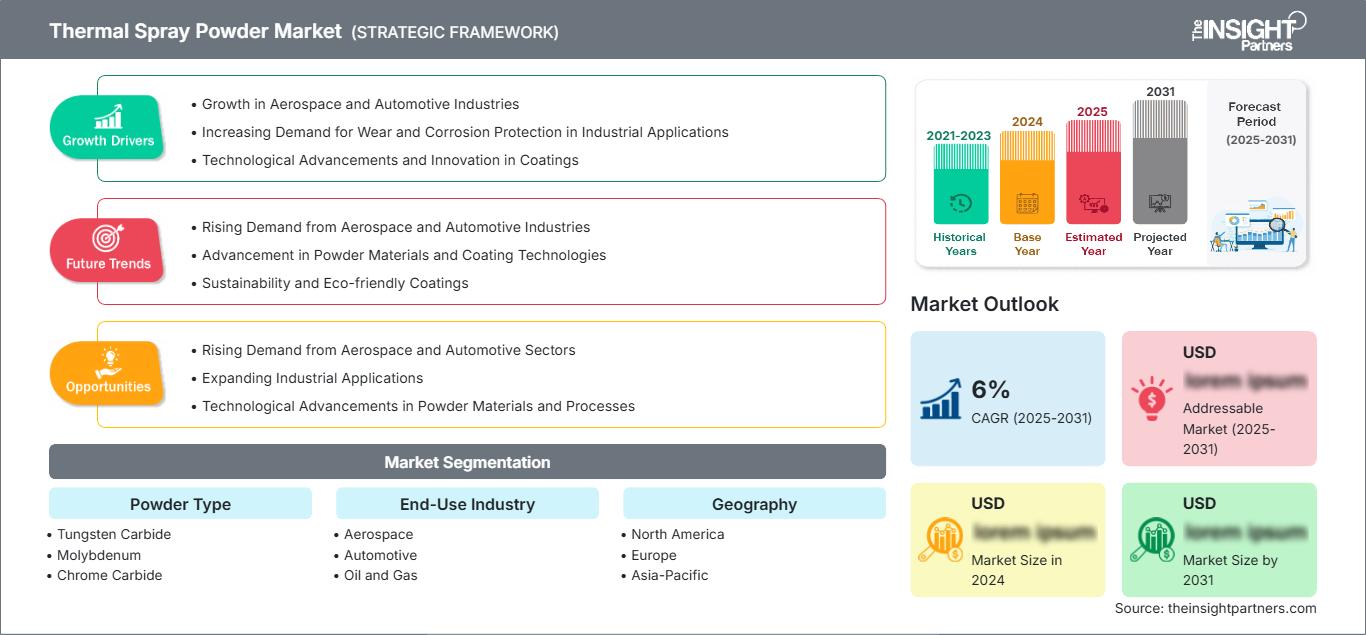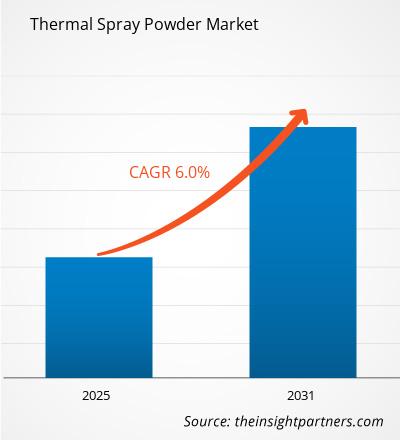Si prevede che il mercato delle polveri per spruzzatura termica registrerà un CAGR del 6% dal 2025 al 2031, con una dimensione del mercato in espansione da XX milioni di dollari nel 2024 a XX milioni di dollari entro il 2031.
Il rapporto sul mercato delle polveri per spruzzatura termica è segmentato per tipologia di polvere (carburo di tungsteno, molibdeno, carburo di cromo, altri). Il mercato è segmentato in base al settore di utilizzo finale (aerospaziale, automobilistico, petrolifero e del gas, energetico e altri). L'ambito di applicazione comprende le dimensioni e le previsioni del mercato a livello globale, regionale e nazionale per tutti i principali segmenti di mercato. Il rapporto offre il valore in USD per l'analisi, i segmenti, le regioni e i paesi sopra indicati. Il rapporto copre le tendenze del mercato, nonché le dinamiche di mercato come fattori trainanti, vincoli e opportunità chiave. Il rapporto include anche l'analisi del panorama industriale e della concorrenza, che include la concentrazione del mercato, l'analisi delle mappe di calore, i principali attori e i recenti sviluppi del mercato.
Scopo del rapporto
Il rapporto "Thermal Spray Powder Market" di The Insight Partners mira a descrivere il panorama attuale e la crescita futura, i principali fattori trainanti, le sfide e le opportunità. Ciò fornirà spunti a vari stakeholder aziendali, come:
- Fornitori/Produttori di tecnologia: per comprendere le dinamiche di mercato in evoluzione e conoscere le potenziali opportunità di crescita, consentendo loro di prendere decisioni strategiche informate.
- Investitori: per condurre un'analisi completa delle tendenze in merito al tasso di crescita del mercato, alle proiezioni finanziarie di mercato e alle opportunità esistenti lungo la catena del valore.
- Enti di regolamentazione: per regolamentare le politiche e le attività di controllo sul mercato con l'obiettivo di ridurre al minimo gli abusi, preservare la fiducia degli investitori e sostenere l'integrità e la stabilità del mercato.
Segmentazione del mercato della polvere per spruzzatura termica Tipo di polvere
- Carburo di tungsteno
- Molibdeno
- Carburo di cromo
Settore di utilizzo finale
- Aerospaziale
- Automotive
- Petrolio e gas
- Energia e potenza
Potrai personalizzare gratuitamente qualsiasi rapporto, comprese parti di questo rapporto, o analisi a livello di paese, pacchetto dati Excel, oltre a usufruire di grandi offerte e sconti per start-up e università
Mercato della polvere per spruzzatura termica: Approfondimenti strategici

-
Ottieni le principali tendenze chiave del mercato di questo rapporto.Questo campione GRATUITO includerà l'analisi dei dati, che vanno dalle tendenze di mercato alle stime e alle previsioni.
Fattori di crescita del mercato delle polveri per spruzzatura termica
- Crescita nei settori aerospaziale e automobilistico: le polveri per spruzzatura termica sono ampiamente utilizzate nei settori aerospaziale e automobilistico per il rivestimento di componenti come pale di turbine, sistemi di scarico e parti di motori. Questi rivestimenti offrono protezione da usura, calore e corrosione, fondamentale per componenti ad alte prestazioni nei motori e in altre applicazioni critiche. L'espansione di questi settori sta alimentando la domanda di polveri per spruzzatura termica.
- Crescente domanda di protezione da usura e corrosione nelle applicazioni industriali: le polveri per spruzzatura termica sono ampiamente utilizzate in settori come la produzione di energia, il petrolio e il gas, la produzione manifatturiera e il settore navale per proteggere macchinari e attrezzature da corrosione, usura ed erosione. La necessità di una maggiore durata e di una maggiore durata dei componenti critici sta determinando la domanda di questi rivestimenti, in particolare in ambienti difficili.
- Progressi tecnologici e innovazione nei rivestimenti: i continui sviluppi nelle formulazioni di polveri per spruzzatura termica, come l'introduzione di nuove leghe e materiali compositi, stanno ampliando la portata del mercato. Questi progressi migliorano le prestazioni, l'efficienza e la convenienza dei rivestimenti. Inoltre, le innovazioni nelle tecnologie di spruzzatura e i processi più rispettosi dell'ambiente contribuiscono alla crescita del mercato, offrendo rivestimenti di qualità superiore e applicazioni industriali più ampie.
Tendenze future del mercato delle polveri per spruzzatura termica
- Crescente domanda nei settori aerospaziale e automobilistico: le polveri per spruzzatura termica sono sempre più utilizzate nei settori aerospaziale e automobilistico per il rivestimento di componenti di motori, pale di turbine e sistemi di scarico. Questi rivestimenti migliorano la resistenza all'usura, alla corrosione e alle alte temperature, essenziale per migliorare la longevità e le prestazioni dei componenti critici in questi settori.
- Progressi nei materiali in polvere e nelle tecnologie di rivestimento: il mercato sta assistendo a una significativa innovazione nelle polveri per spruzzatura termica, con i produttori che sviluppano materiali ad alte prestazioni come ceramiche, metalli e polveri composite. Questi materiali avanzati offrono una protezione superiore in ambienti difficili, rendendoli ideali per settori come quello petrolifero e del gas, energetico e manifatturiero, dove sono richiesti rivestimenti robusti e affidabili.
- Sostenibilità e rivestimenti ecocompatibili: con la crescente attenzione alla sostenibilità, cresce la domanda di polveri per spruzzatura termica ecocompatibili. Tra queste, polveri con emissioni tossiche basse o nulle, nonché polveri che riducono il consumo energetico durante l'applicazione. I produttori si stanno concentrando sullo sviluppo di polveri sostenibili in linea con le normative ambientali e la crescente tendenza verso processi di produzione ecosostenibili in diversi settori.
Opportunità di mercato per le polveri a spruzzo termico
- Crescente domanda nei settori aerospaziale e automobilistico: le polveri a spruzzo termico sono ampiamente utilizzate nei settori aerospaziale e automobilistico per il rivestimento di componenti ad alte prestazioni come pale di turbine, componenti di motori e sistemi frenanti. Queste polveri offrono un'eccellente resistenza all'usura, alla corrosione e alle alte temperature, rendendole essenziali per il mantenimento delle prestazioni e della longevità dei componenti critici in questi settori. La crescita della produzione aeronautica e automobilistica sta aumentando la domanda di polveri a spruzzo termico.
- Applicazioni industriali in espansione: l'uso delle polveri a spruzzo termico è in crescita in diverse applicazioni industriali, tra cui la produzione di energia, il petrolio e il gas e i macchinari pesanti. Questi settori si affidano alle polveri a spruzzo termico per il rivestimento di componenti esposti a condizioni estreme, come pompe, valvole e apparecchiature in ambienti difficili. La crescente domanda di componenti industriali durevoli e ad alte prestazioni sta trainando la crescita del mercato.
- Progressi tecnologici nei materiali e nei processi in polvere: le innovazioni nei materiali in polvere, incluso lo sviluppo di nuove leghe e rivestimenti, stanno migliorando le capacità delle polveri termospruzzate. I progressi nelle tecnologie di rivestimento a spruzzo, come il miglioramento delle dimensioni delle particelle di polvere e delle tecniche di deposizione, stanno aumentando l'efficienza e la qualità dei rivestimenti, rendendo le polveri termospruzzate più interessanti per un'ampia gamma di applicazioni.
Approfondimenti regionali sul mercato delle polveri termiche spray
Le tendenze regionali e i fattori che influenzano il mercato delle polveri per spruzzatura termica durante il periodo di previsione sono stati ampiamente spiegati dagli analisti di The Insight Partners. Questa sezione illustra anche i segmenti e la geografia del mercato delle polveri per spruzzatura termica in Nord America, Europa, Asia-Pacifico, Medio Oriente e Africa, America Meridionale e Centrale.
Ambito del rapporto di mercato sulla polvere per spruzzatura termica
| Attributo del rapporto | Dettagli |
|---|---|
| Dimensioni del mercato in 2024 | US$ XX million |
| Dimensioni del mercato per 2031 | US$ XX Million |
| CAGR globale (2025 - 2031) | 6% |
| Dati storici | 2021-2023 |
| Periodo di previsione | 2025-2031 |
| Segmenti coperti |
By Tipo di polvere
|
| Regioni e paesi coperti |
Nord America
|
| Leader di mercato e profili aziendali chiave |
|
Densità degli operatori del mercato delle polveri per spruzzatura termica: comprendere il suo impatto sulle dinamiche aziendali
Il mercato delle polveri per spruzzatura termica è in rapida crescita, trainato dalla crescente domanda degli utenti finali, dovuta a fattori quali l'evoluzione delle preferenze dei consumatori, i progressi tecnologici e una maggiore consapevolezza dei vantaggi del prodotto. Con l'aumento della domanda, le aziende stanno ampliando la propria offerta, innovando per soddisfare le esigenze dei consumatori e sfruttando le tendenze emergenti, alimentando ulteriormente la crescita del mercato.

- Ottieni il Mercato della polvere per spruzzatura termica Panoramica dei principali attori chiave
Punti di forza
- Copertura completa: il rapporto analizza in modo esaustivo prodotti, servizi, tipologie e utenti finali del mercato delle polveri per spruzzatura termica, fornendo un panorama olistico.
- Analisi degli esperti: il rapporto è redatto sulla base della conoscenza approfondita di esperti e analisti del settore.
- Informazioni aggiornate: il rapporto garantisce la pertinenza aziendale grazie alla copertura di informazioni e tendenze dei dati recenti.
- Opzioni di personalizzazione: questo rapporto può essere personalizzato per soddisfare le esigenze specifiche del cliente e adattarsi in modo appropriato alle strategie aziendali.
Il rapporto di ricerca sul mercato delle polveri per spruzzatura termica può quindi aiutare a guidare il percorso di decodificazione e comprensione dello scenario del settore e delle prospettive di crescita. Sebbene possano esserci alcune preoccupazioni valide, i vantaggi complessivi di questo rapporto tendono a superare gli svantaggi.
- Analisi storica (2 anni), anno base, previsione (7 anni) con CAGR
- Analisi PEST e SWOT
- Valore/volume delle dimensioni del mercato - Globale, Regionale, Nazionale
- Industria e panorama competitivo
- Set di dati Excel
Report recenti
Testimonianze
Motivo dell'acquisto
- Processo decisionale informato
- Comprensione delle dinamiche di mercato
- Analisi competitiva
- Analisi dei clienti
- Previsioni di mercato
- Mitigazione del rischio
- Pianificazione strategica
- Giustificazione degli investimenti
- Identificazione dei mercati emergenti
- Miglioramento delle strategie di marketing
- Aumento dell'efficienza operativa
- Allineamento alle tendenze normative






















 Ottieni un campione gratuito per - Mercato della polvere per spruzzatura termica
Ottieni un campione gratuito per - Mercato della polvere per spruzzatura termica